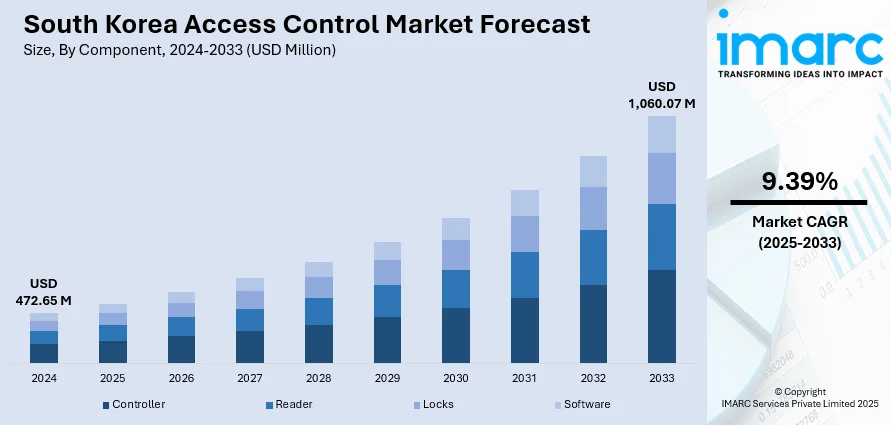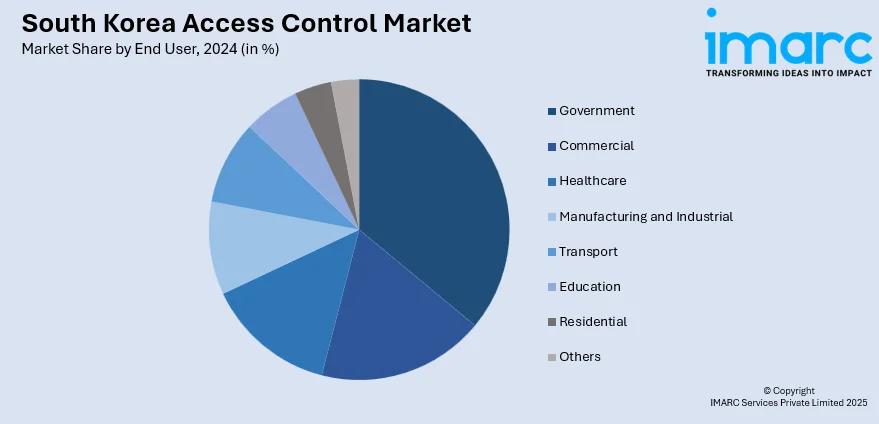
South Korea Access Control Market Size, Share, Trends and Forecast by Component, Type, End User, and Region, 2025-2033
South Korea Access Control Market Overview:
The South Korea access control market size reached USD 472.65 Million in 2024. The market is projected to reach USD 1,060.07 Million by 2033, exhibiting a growth rate (CAGR) of 9.39% during 2025-2033. The market is driven by rapid smart city and Internet of Things (IoT) adoption, increasing use of biometrics and mobile credentials, strict data protection and building security regulations, and growth in commercial and healthcare construction. Additional factors include government investment in critical infrastructure security, rising workplace and public safety concerns, migration to cloud-based and integrated security platforms, heightened demand for contactless solutions post-pandemic, security needs for an aging population in assisted-living facilities, favorable financing options, and strong partnerships between system integrators and tech startups thus contributing to the South Korea access control market share.
|
Report Attribute
|
Key Statistics
|
|---|---|
|
Base Year
|
2024
|
|
Forecast Years
|
2025-2033
|
|
Historical Years
|
2019-2024
|
| Market Size in 2024 | USD 472.65 Million |
| Market Forecast in 2033 | USD 1,060.07 Million |
| Market Growth Rate 2025-2033 | 9.39% |
South Korea Access Control Market Trends:
Rapid Smart City Development and IoT Integration
South Korea’s aggressive investment in smart cities, fueled by government initiatives like the “Smart City Master Plan,” is a key South Korea access control market trends. As urban areas become digitally interconnected, integrating access control systems with IoT devices allows for real-time monitoring, automation, and data-driven security decisions. Residential complexes, public facilities, and transportation hubs increasingly deploy biometric entry systems, smart cards, and mobile-based credentials. IoT-enabled access control not only enhances security but also improves user convenience, enabling remote management and predictive maintenance. The push for green, efficient, and tech-forward cities also aligns with cloud-based access control solutions, ensuring scalability and interoperability. With cities like Songdo and Busan serving as flagship projects, this integration trend is expected to accelerate, creating strong demand for advanced, networked access control technologies.

To get more information on this market, Request Sample
Strict Security Regulations and Compliance Requirements
South Korea enforces stringent security and privacy regulations, which significantly drive the access control market. Laws such as the Personal Information Protection Act (PIPA) mandate robust safeguards for sensitive data, prompting organizations to adopt advanced, compliant systems. Sectors like finance, healthcare, defense, and government facilities require highly secure authentication methods, including multi-factor biometric verification and encrypted access logs. Compliance not only minimizes the risk of data breaches but also strengthens public trust in service providers. In addition, workplace safety laws and fire safety codes encourage integrated access control with emergency evacuation features. These regulations create consistent South Korea access control market growth for certified, standards-compliant solutions. Vendors offering systems that meet local certifications gain a competitive edge, while organizations view investment in advanced access control as a necessary step to avoid penalties, reputational damage, and operational disruptions.
Post-Pandemic Demand for Contactless and Mobile Solutions
The COVID-19 pandemic accelerated demand for contactless and mobile-based access control in South Korea, reshaping workplace and facility management practices. Organizations now prioritize solutions that minimize physical touchpoints, such as facial recognition, QR code scanning, and smartphone-based NFC access. This shift is particularly evident in corporate offices, hospitals, educational institutions, and residential complexes. Contactless systems not only reduce infection risk but also offer operational advantages like faster entry processing, remote access management, and integration with health monitoring systems. The trend aligns with the country’s high smartphone penetration and tech-savvy population, making mobile credentials an attractive option. Post-pandemic, these solutions have moved from being a temporary precaution to a long-term standard, supported by both user preference and corporate health policies. As remote work models persist, demand for flexible, remotely managed access control continues to rise.
South Korea Access Control Market Segmentation:
IMARC Group provides an analysis of the key trends in each segment of the market, along with forecasts at the country and regional levels for 2025-2033. Our report has categorized the market based on component, type, and end user.
Component Insights:
- Controller
- Reader
- Locks
- Software
The report has provided a detailed breakup and analysis of the market based on the component. This includes controller, reader, locks, and software.
Type Insights:
- Card Based
- Contact
- Contactless
- Biometric Based
- Fingerprint
- Face Recognition
- Face Recognition and Fingerprint
- Iris Recognition
- Others
A detailed breakup and analysis of the market based on the type have also been provided in the report. This includes card based (contact, contactless), and biometric based (fingerprint, face recognition, face recognition and fingerprint, iris recognition, and others).
End User Insights:

- Government
- Commercial
- Healthcare
- Manufacturing and Industrial
- Transport
- Education
- Residential
- Others
A detailed breakup and analysis of the market based on the end user have also been provided in the report. This includes government, commercial, healthcare, manufacturing and industrial, transport, education, residential, and others.
Regional Insights:
- Seoul Capital Area
- Yeongnam (Southeastern Region)
- Honam (Southwestern Region)
- Hoseo (Central Region)
- Others
The report has also provided a comprehensive analysis of all the major regional markets, which include Seoul Capital Area, Yeongnam (Southeastern Region), Honam (Southwestern Region), Hoseo (Central Region), and others.
Competitive Landscape:
The market research report has also provided a comprehensive analysis of the competitive landscape. Competitive analysis such as market structure, key player positioning, top winning strategies, competitive dashboard, and company evaluation quadrant has been covered in the report. Also, detailed profiles of all major companies have been provided.
South Korea Access Control Market News:
- In July 2025, South Korea launched a Mobile Overseas Korean Identity Verification Card, extending its mobile digital ID system to citizens abroad. Building on the domestic rollout to 52 million residents by March 2025, the initiative allows overseas Koreans to access government, banking, healthcare, and e-commerce services without a domestic phone number. Verification involves secure document uploads and live video calls, ensuring accessibility, security, and stronger ties with the global Korean community.
- In March 2025, Hyundai Motor Group and Suprema signed an MoU to develop AI-driven, robot-friendly building security solutions. Building on a successful deployment at Factorial Seongsu, the partnership will integrate facial recognition, robotics, and access control to create new industry standards. The collaboration aims to advance AIoT opportunities, develop certifications, and deliver unified, autonomous security systems combining cloud, sensors, and advanced automation technologies for next-generation unmanned building services.
South Korea Access Control Market Report Coverage:
| Report Features | Details |
|---|---|
| Base Year of the Analysis | 2024 |
| Historical Period | 2019-2024 |
| Forecast Period | 2025-2033 |
| Units | Million USD |
| Scope of the Report | Exploration of Historical Trends and Market Outlook, Industry Catalysts and Challenges, Segment-Wise Historical and Future Market Assessment:
|
| Components Covered | Controller, Reader, Locks, Software |
| Types Covered |
|
| End Users Covered | Government, Commercial, Healthcare, Manufacturing and Industrial, Transport, Education, Residential, Others |
| Regions Covered | Seoul Capital Area, Yeongnam (Southeastern Region), Honam (Southwestern Region), Hoseo (Central Region), Others |
| Customization Scope | 10% Free Customization |
| Post-Sale Analyst Support | 10-12 Weeks |
| Delivery Format | PDF and Excel through Email (We can also provide the editable version of the report in PPT/Word format on special request) |
Key Questions Answered in This Report:
- How has the South Korea access control market performed so far and how will it perform in the coming years?
- What is the breakup of the South Korea access control market on the basis of component?
- What is the breakup of the South Korea access control market on the basis of type?
- What is the breakup of the South Korea access control market on the basis of end user?
- What is the breakup of the South Korea access control market on the basis of region?
- What are the various stages in the value chain of the South Korea access control market?
- What are the key driving factors and challenges in the South Korea access control market?
- What is the structure of the South Korea access control market and who are the key players?
- What is the degree of competition in the South Korea access control market?
Key Benefits for Stakeholders:
- IMARC’s industry report offers a comprehensive quantitative analysis of various market segments, historical and current market trends, market forecasts, and dynamics of the South Korea access control market from 2019-2033.
- The research report provides the latest information on the market drivers, challenges, and opportunities in the South Korea access control market.
- Porter's five forces analysis assist stakeholders in assessing the impact of new entrants, competitive rivalry, supplier power, buyer power, and the threat of substitution. It helps stakeholders to analyze the level of competition within the South Korea access control industry and its attractiveness.
- Competitive landscape allows stakeholders to understand their competitive environment and provides an insight into the current positions of key players in the market.
Need more help?
- Speak to our experienced analysts for insights on the current market scenarios.
- Include additional segments and countries to customize the report as per your requirement.
- Gain an unparalleled competitive advantage in your domain by understanding how to utilize the report and positively impacting your operations and revenue.
- For further assistance, please connect with our analysts.
 Request Customization
Request Customization
 Speak to an Analyst
Speak to an Analyst
 Request Brochure
Request Brochure
 Inquire Before Buying
Inquire Before Buying




.webp)




.webp)












